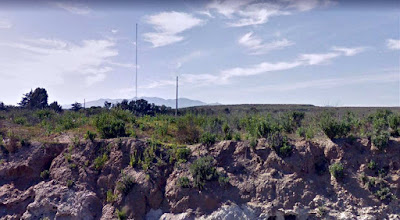 Last weekend's CLE yielded a mixed-bag of propagation. Friday night's
conditions were the best of the three nights here in southwest B.C., but others found things a
little different ... such are the vagaries of radio's magic.
Last weekend's CLE yielded a mixed-bag of propagation. Friday night's
conditions were the best of the three nights here in southwest B.C., but others found things a
little different ... such are the vagaries of radio's magic.All told, I logged 40 NDBs in the specified frequency ranges, with five of the logs being all time 'new catches'. After chasing NDBs regularly since the mid-80's, new ones do not come along too often. It's now fairly clear that as the Sun seriously starts to quiet down once again, propagation on the lower bands, especially the MF and LF part of the spectrum, is quickly improving ... a nice change over the past several years of continuous prop-killing geomagnetic activity during the downhill slide of Cycle 24. It looks as though things will be much better over the next several years as things get even quieter.
The highlight of the weekend was 'TOY' - 260kHz, from Tongoy, Chile. Although on the air for many years, this was the first time I have ever heard it ... on both Friday and Sunday evenings.
Located in coastal central Chile, 'TOY' runs some serious power at 3,000 watts. Along with its large vertical and rural location, I'm surprised I haven't heard it before.
 |
| Tongoy, Chile courtesy: https://www.google.ca/maps |
The nearby airstrip in seaside Tongoy is apparently no longer in service and the beacon appears to be an 'enroute' navigational beacon, similar to the high-powered ones in many unpopulated regions of northern Canada.
 |
| TOY-260 courtesy: https://www.google.ca/maps |
 |
| Tongoy Airstrip courtesy: https://www.google.ca/maps |
I have to wonder just how long beacons of this type will be useful enough to maintain as most aero navigation is now reliant on much more accurate GPS, RNAV and RNP systems ... time will tell, but NDBs appear to be going silent with increasing frequency throughout North America.
Another highlight was 500-watter 'QY'-263kHz, located in the heart of Sydney, Nova Scotia and not logged here since 2013. 'QY's large vertical appears to be located in a residential area, but perhaps the beacon was there long before the neighbours moved in. I'll put 'QY' into the receiver's memory as a good indicator of propagation to the east.
 |
| QY-263 Sydney, NS courtesy: https://www.google.ca/maps |
Logged using the Perseus SDR and inverted-L tuned to 300 kHz:
27 08:00 260.0 TOY Tongoy, CHL
27 08:00 260.0 ZXS Prince George, BC, CAN
27 08:00 260.0 YSQ Atlin, BC, CAN
27 06:00 260.0 MTH Marathon, FL, USA
27 06:00 260.0 JH Jackson, MS, USA
27 07:00 260.0 SNE Santa Elena, TX, USA
27 08:00 261.0 D6 Fairmont Hot Springs, BC, CAN
27 08:00 263.0 OAY Norton Bay, ALS
27 06:00 263.0 CVM Alton, IL, USA
27 10:00 263.0 3Z Russell, MB, CAN
27 07:00 263.0 BF Scottsbluff, NE, USA
27 06:00 263.0 QY Sydney, NS, CAN
27 10:00 263.0 YBB Kugaaruk, NU, CAN
27 07:00 263.0 ZQT Thunder Bay, ON, CAN
27 11:00 264.0 SZT Sandpoint Apt, ID, USA
27 08:00 264.0 ZPB Sachigo Lake, ON, CAN
27 10:00 266.0 ICK Annette Island, ALS
27 14:00 266.0 XD Edmonton, AB, CAN
27 14:00 266.0 VR Vancouver, BC, CAN
27 05:00 266.0 BZ Bozeman, MT, USA
27 08:00 266.0 GH Fort Good Hope, NT, CAN
27 07:00 266.0 SLE Salem, OR, USA
29 09:00 266.0 PYX Perryton Ochiltree Co Apt, TX, USA
27 05:00 268.0 ZWL Wollaston Lake, SK, CAN
27 05:00 269.0 YK Castlegar, BC, CAN
29 10:00 269.0 BEX Bloomfield, IA, USA
27 06:00 269.0 UDE Delta Station, MB, CAN
27 06:00 269.0 PK Park Rapids, MN, USA
27 14:00 269.0 ZW Teslin, YT, CAN
27 07:00 512.0 HMY Lexington, OK, USA
27 07:00 515.0 OS Columbus, OH, USA
27 06:00 515.0 PN Ponca City, OK, USA
27 07:00 515.0 CL Cresent Beach, WA, USA
27 05:00 516.0 YWA Petawawa, ON, CAN
27 07:00 521.0 ORC Orange City, IA, USA
27 05:00 524.0 MNL Valdez, ALS
27 05:00 524.0 HRD Hardin, TX, USA
27 07:00 525.0 ICW Nenana, ALS
27 05:00 529.0 SQM Sumner Strait, ALS
27 13:00 529.0 FDV Nome, ALS
The logs / reports from all participants may be viewed (once they have been posted) here on the NDB List website.





